Research and Application of Supersaturated Dissolved Oxygen Technology Combined with Magnetization Technology in the Improvement of Water Quality: Taking the South-to-North Water Diversion Project of China as a Pilot Project
Abstract
:1. Introduction
2. Materials and Methods
2.1. Study Site
2.2. Reconstruction Layout of Experimental Site
2.3. Design of the Experiment
2.3.1. Static Experiment
2.3.2. Dynamic Experiment
2.4. Sampling and Analysis
Statistical Analysis
3. Results and Analysis
3.1. Temporal Variations of DO Concentration and Organic Matter Removal in Static Experiment
3.2. Temporal Variations of DO Concentration and Organic Matter Removal in Dynamic Experiment
3.3. Effects of the SDOXM System on Microbial Activity in Dynamic Experiment
3.4. Phytoplankton Community Composition
3.5. Relation between Phytoplankton Species and Environmental Factors
4. Discussion
4.1. Effects of the SDOXM System on DO Concentration
4.2. Effects of the SDOXM System on Water Environmental Factors
4.3. Effects of the SDOXM System on Phytoplankton
4.4. Operating Cost of the SDOXM System
5. Conclusions
Author Contributions
Funding
Institutional Review Board Statement
Informed Consent Statement
Data Availability Statement
Acknowledgments
Conflicts of Interest
References
- Wei, Y.; Chao, W.; Xiaokang, X. Thinkings on water quality management of main channel in Middle Route of South-to-North Water Transfer Project. Yangtze River 2020, 51, 17–24. [Google Scholar]
- Sun, J.; Han, P.; Wang, C.; Xin, X.; Lei, J.; Yin, W. Study on the comprehensive evaluation of water quality status of the middle route main channel of the South-to-North Water Diversion Project. South-North Water Transf. Water Sci. 2019, 17, 102–112. [Google Scholar]
- Nong, X.; Dongguo, S.; Zhong, H.; Liang, B. Evaluation of water quality in the South-to-North Water Diversion Project of China using the Water Quality Index (WQI) Method. Water Res. 2020, 178, 115781. [Google Scholar] [CrossRef] [PubMed]
- Liang, J.; Xin, X.; Lu, L.; Hu, S.; Zhu, D.; Tang, J. Analysis of water quality variation and potential pollution sources in main channel of Middle Route Project of South to North Water Diversion. Yangtze River 2017, 48, 6–9. [Google Scholar]
- Hoffmann, C.C.; Ba Attrup-Pedersen, A. Re-establishing freshwater wetlands in Denmark. Ecol. Eng. 2007, 30, 157–166. [Google Scholar] [CrossRef]
- Gs, A.; Rg, A.; Sfr, A.; Uha, B. The use of pure oxygen for aeration in aerobic wastewater treatment: A review of its potential and limitations. Bioresour. Technol. 2020, 312, 123595. [Google Scholar]
- Chibowski, E.; Szcze, A. Magnetic water treatment–a review of the latest approaches. Chemosphere 2018, 203, 54–67. [Google Scholar] [CrossRef]
- Mohammed, R.R.; Ketabchi, M.R.; Mckay, G. Combined magnetic field and adsorption process for treatment of biologically treated palm oil mill effluent (POME). Chem. Eng. J. 2014, 243, 31–42. [Google Scholar] [CrossRef]
- Zielinski, M.; Rusanowska, P.; Debowski, M.; Hajduk, A. Influence of static magnetic field on sludge properties. Sci. Total Environ. 2018, 625, 738–742. [Google Scholar] [CrossRef]
- Wang, Y.; Gu, X.; Quan, J.; Xing, G.; Hu, Y. Application of magnetic fields to wastewater treatment and its mechanisms: A review. Sci. Total Environ. 2021, 773, 145476. [Google Scholar] [CrossRef]
- Gu, S.; Lian, F.; Yan, K.; Zhang, W. Application of polymeric ferric sulfate combined with cross-frequency magnetic field in the printing and dyeing wastewater treatment. Water Sci. Technol. A J. Int. Assoc. Water Pollut. Res. 2019, 80, 1562–1570. [Google Scholar] [CrossRef] [PubMed]
- Wang, X.; Wang, P. Biological effects of magnetization in sewage treatment. Environ. Sci. Technol. 2000, 2, 33–36. [Google Scholar]
- Ji, Y.; Wang, Y.; Sun, J.; Yan, T.; Jing, L.; Zhao, T.; Yin, X.; Sun, C. Enhancement of biological treatment of wastewater by magnetic field. Bioresour. Technol. 2010, 101, 8535–8540. [Google Scholar] [CrossRef] [PubMed]
- Morrow, A.C.; Dunstan, R.H.; King, B.V.; Roberts, T.K. Metabolic effects of static magnetic fields on streptococcus pyogenes. Bioelectromagnetics 2010, 28, 439–445. [Google Scholar] [CrossRef]
- Tomska, A.; Wolny, L. Enhancement of biological wastewater treatment by magnetic field exposure. Desalination 2008, 222, 368–373. [Google Scholar] [CrossRef]
- Zhai, Y.; Ju, S. Experiment on the improvement of surface water quality by supersaturated dissolved oxygen. Water Purif. Technol. 2019, 38, 60–63. [Google Scholar]
- Pan, Z.; Yu, D. Experimental and features automatic supersaturated aerator. Sci. Technol. 2015, 7, 5–6. [Google Scholar]
- Sang, Y.K.; Lopez-Vazquez, C.M.; Curko, J.; Matosic, M.; Garcia, H.A. Supersaturated-oxygen aeration effects on a high-loaded membrane bioreactor (HL-MBR): Biological performance and microbial population dynamics. Sci. Total Environ. 2020, 771, 144847. [Google Scholar]
- Gabrielli, C.; Jaouhari, R.; Maurin, G.; Ke Dd Am, M. Magnetic water treatment for scale prevention. Water Res. 2001, 35, 3249–3259. [Google Scholar] [CrossRef]
- Yoshida, A.; Takahashi, O.; Ishii, Y.; Sekimoto, Y.; Kurata, Y. Water purification using the adsorption characteristics of microbubbles. Jpn. J. Appl. Phys. 2008, 47, 6574–6577. [Google Scholar] [CrossRef]
- Hu, H.; Wei, Y. The Freshwater Algae of China—Systematics, Taxonomy and Ecology; Science Press: Beijing, China, 2006. [Google Scholar]
- Zhang, Q.; Liu, G.; Hu, Z. Study on freshwater genus Peridiniopsis (Dinophyta) from China. Acta Hydrobiol. Sin. 2012, 36, 751–765. [Google Scholar]
- Sun, C.C.; Wang, Y.S.; Sun, S.; Zhang, F.Q. Analysis dynamics of phytoplankton community characteristics in Daya Bay. Acta Ecol. Sin. 2006, 12, 3948–3958. [Google Scholar]
- NEPAC—The National Environmental Protection Agency of China; Ministry of Environmental Protection of the People’s Republic of China. Standard Methods for the Examination of Water and Wastewater; Environmental Science Press: Beijing, China, 2002. [Google Scholar]
- Hao, Y.; Sun, G.; Zhang, L.; Gong, X.; Xu, S.; Liu, H.; Zhang, F. Relationship between community characteristics of the phytoplankton and environmental factors in Heihe River basin. J. Lake Sci. 2014, 26, 121–130. [Google Scholar]
- Lepš, J.; Amilauer, P. Multivariate Analysis of Ecological Data Using CANOCO 5; Cambridge University Press: Cambridge, UK, 2003. [Google Scholar]
- Wickham, H. Ggplot2: Elegant Graphics for Data Analysis; ggplot2: Elegant Graphics for Data Analysis; Springer: New York, NY, USA, 2009. [Google Scholar]
- Wood, S.N. Fast stable restricted maximum likelihood and marginal likelihood estimation of semiparametric generalized linear models. J. R. Stat. Soc. Ser. B Stat. Methodol. 2011, 73, 3–36. [Google Scholar] [CrossRef] [Green Version]
- Du, L.; Trinh, X.; Chen, Q.; Wang, C.; Wang, H.; Xia, X.; Zhou, Q.; Xu, D.; Wu, Z. Enhancement of microbial nitrogen removal pathway by vegetation in Integrated Vertical-Flow Constructed Wetlands (IVCWs) for treating reclaimed water. Bioresour. Technol. 2017, 249, 644–651. [Google Scholar] [CrossRef]
- Zhab, C.; Jing, D.D.; Zsb, C.; Rui, M.C.; Yzb, C.; Xc, E.; Xf, E.; Cy, A. Nitrogen removal of anaerobically digested swine wastewater by pilot-scale tidal flow constructed wetland based on in-situ biological regeneration of zeolite. Chemosphere 2019, 217, 364–373. [Google Scholar]
- Liu, Y.; Shi, H.; Xia, L.; Shi, H.; Shen, T.; Wang, Z.; Wang, G.; Wang, Y. Study of operational conditions of simultaneous nitrification and denitrification in a Carrousel oxidation ditch for domestic wastewater treatment. Bioresour. Technol. 2010, 101, 901–906. [Google Scholar] [CrossRef]
- Mahapatra, D.M.; Chanakya, H.N.; Ramachandra, T.C. Treatment efficacy of algae-based sewage treatment plants. Environ. Monit. Assess. 2013, 185, 7145–7164. [Google Scholar] [CrossRef]
- Trabelsi, L.; Ouada, H.B.; Zili, F.; Mazhoud, N.; Ammar, J. Evaluation of Arthrospira platensis extracellular polymeric substances production in photoautotrophic, heterotrophic and mixotrophic conditions. Folia Microbiol. 2013, 58, 39–45. [Google Scholar] [CrossRef]
- Rangarajan, C.; Mishra, P. Simultaneous nitrification and denitrification in biofilters with real time aeration control. Water Sci. Technol. 2001, 43, 269–276. [Google Scholar]
- Chen, F.C.; Godwin, S.L. Comparison of a rapid ATP bioluminescence assay and standard plate count methods for assessing microbial contamination of consumers’ refrigerators. J. Food Protect. 2006, 69, 2534–2538. [Google Scholar] [CrossRef]
- Wei, L.; Kang, K.; Liu, Q.; Liu, Y. Investigation on water quality assessment model of surface water with high dissolved oxygen and potassium permanganate index. Environ. Sci. Manag. 2014, 39, 178–182. [Google Scholar]
- Sha, H.; Fan, L. Study on relative characteristics between DO, CODCr and CODMn on surface water. GuangZhou Chem. Ind. 2021, 49, 105–106. [Google Scholar]
- Zhang, C.; Zhu, Y.; Song, G.; Wujuan, M.; Bi, Y.; Wang, S.; Ling, J.; Shang, M. Spatiotemporal pattern of phytoplankton community structure and its determining factors in the channel of the middle route of South-to-North Water Diversion Project. J. Lake Sci. 2021, 33, 675–686. [Google Scholar]
- Zhang, C.; Mi, W.; Xu, Y.; Song, G.; Zhu, Y.; Bi, Y. Phytoplankton community characteristics and water environment assessment in the Main Channel of the Middle Route of the South-to-North Water Diversion Project. J. Hydroecol. 2021, 42, 47–54. [Google Scholar]
- Wu, L.; Yu, Y.; Zhang, T.; Feng, W.; Zhang, X.; Li, W.; Wu, L.; Yu, Y.; Zhang, T.; Feng, W. PCR-DGGE fingerprinting analysis of plankton communities and its relationship to lake trophic status. Int. Rev. Hydrobiol. 2010, 94, 528–541. [Google Scholar] [CrossRef]
- Trombetta, T.; Vidussi, F.; Mas, S.; Parin, D.; Mostajir, B. Water temperature drives phytoplankton blooms in coastal waters. PLoS ONE 2019, 14, e214933. [Google Scholar] [CrossRef] [Green Version]
- Bergström, A.K. The use of TN:TP and DIN:TP ratios as indicators for phytoplankton nutrient limitation in oligotrophic lakes affected by N deposition. Aquat. Sci. 2010, 72, 277–281. [Google Scholar] [CrossRef]
- Redfield, A.C. The biological control of chemical factors in the environment. Am. Sci. Sci. Prog. 1960, 11, 150–170. [Google Scholar]
- Reynolds, C.S.; Vera, H.; Carla, K.; Luigi, N.F.; Sergio, M. Towards a functional classification of the freshwater phytoplankton. J. Plankton Res. 2002, 24, 417–428. [Google Scholar] [CrossRef]
- Yang, W.; Deng, D.G.; Meng, X.L.; Zhang, S. Temporal and spatial variations of phytoplankton Community Structure in Lake Erhai, a Chinese plateau lake, with reference to environmental factors. Russ. J. Ecol. 2019, 50, 352–360. [Google Scholar] [CrossRef]
- Stamou, G.; Katsiapi, M.; Moustaka-Gouni, M.; Michaloudi, E. Trophic state assessment based on zooplankton communities in Mediterranean lakes. Hydrobiologia 2019, 884, 83–103. [Google Scholar] [CrossRef]
- Chao, W.; Hong, Z.; Pei, L.; Xiaokang, X.; Aijing, Z.; Wei, Y. Evidence on the causes of the rising levels of CODMn along the middle route of the South-to-North Diversion Project in China: The role of algal dissolved organic matter. J. Environ. Sci.-China 2022, 113, 281–290. [Google Scholar]


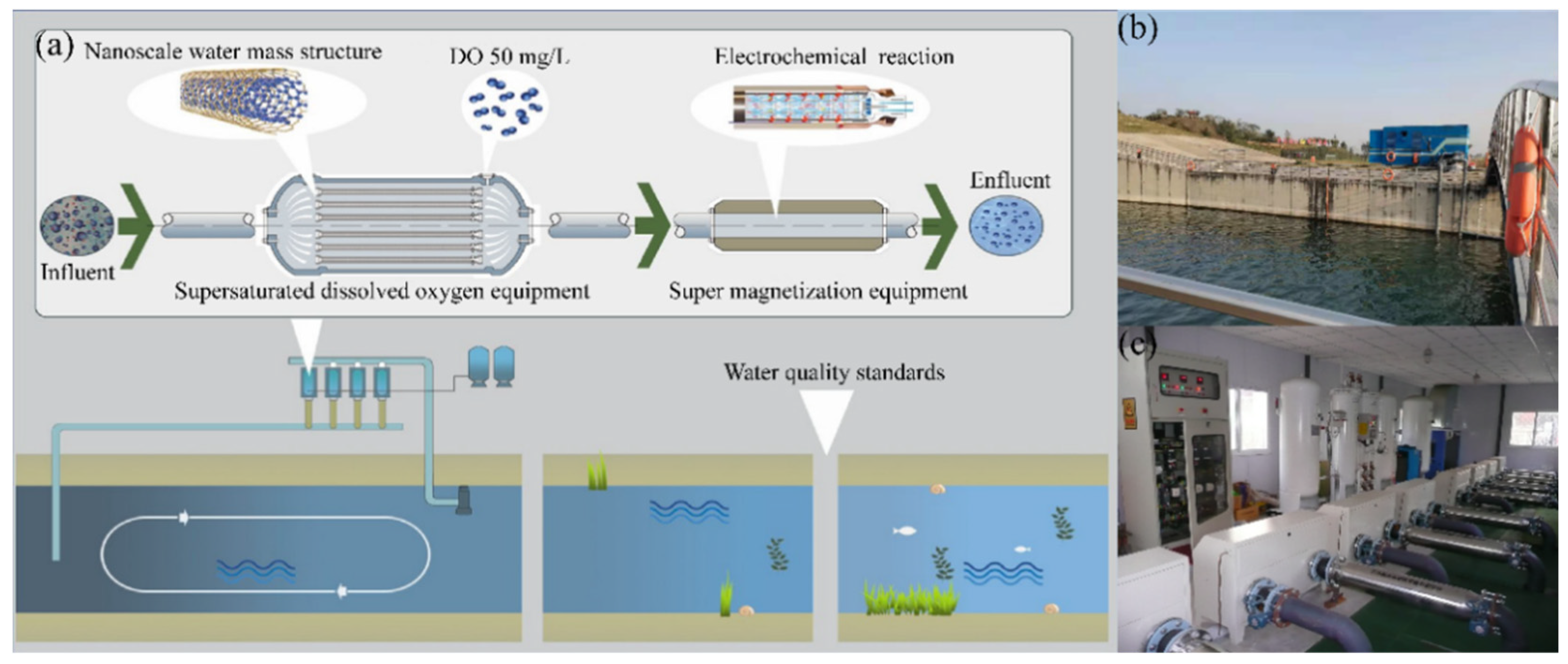


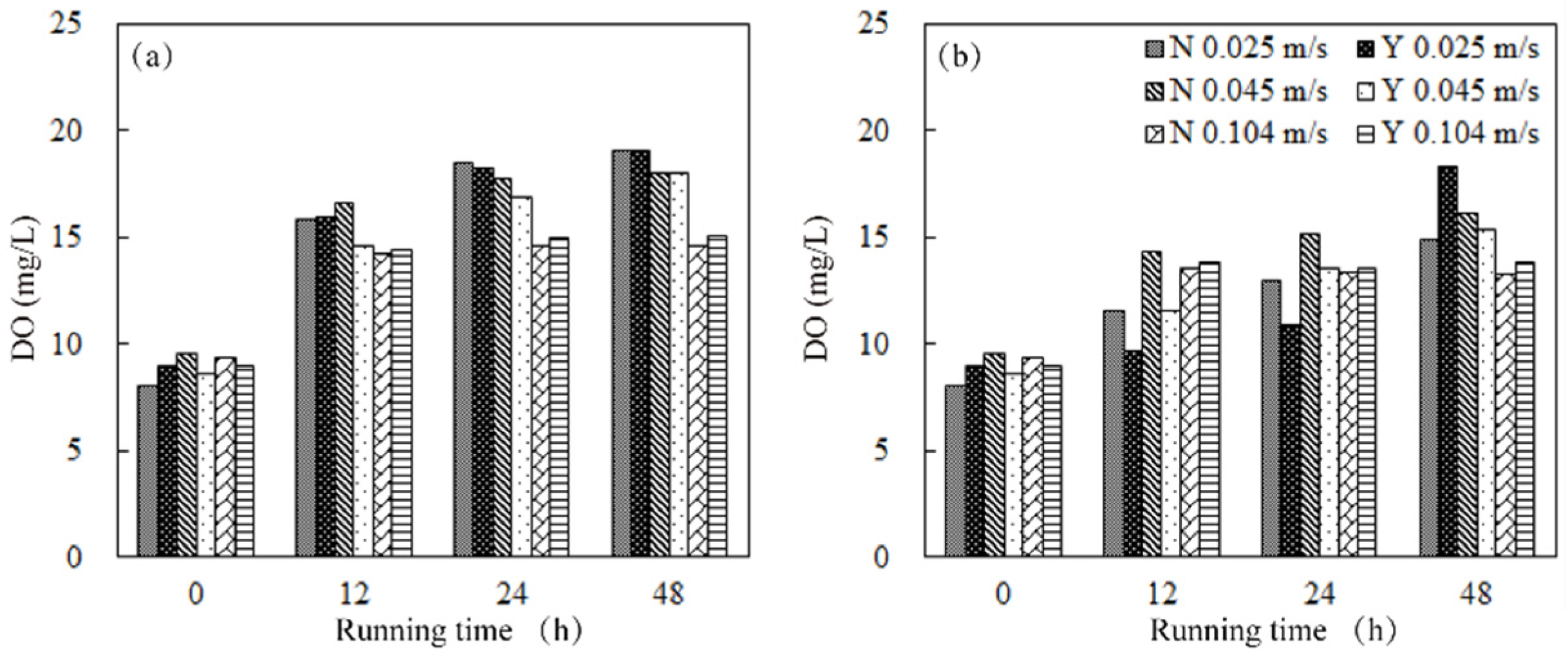

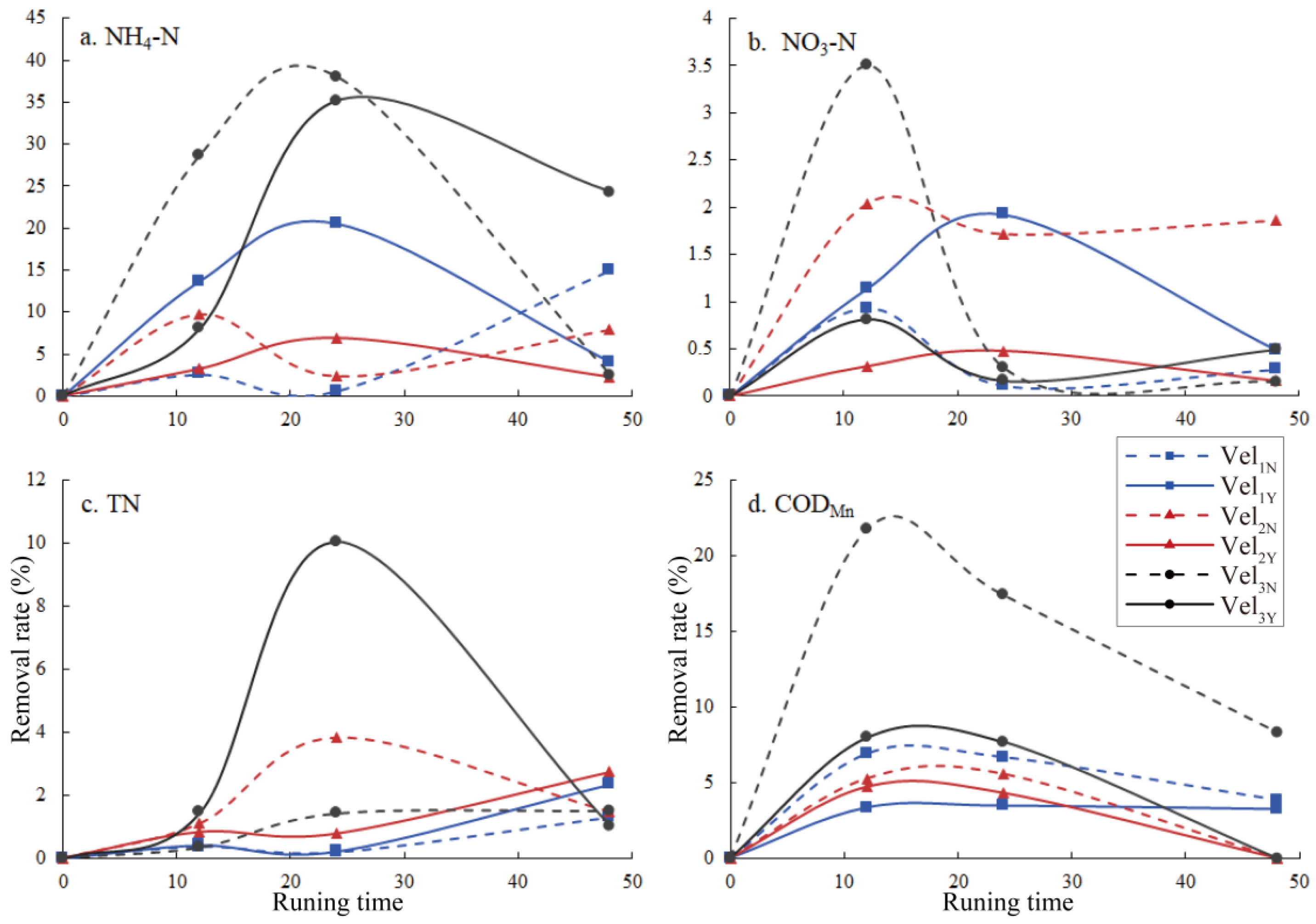
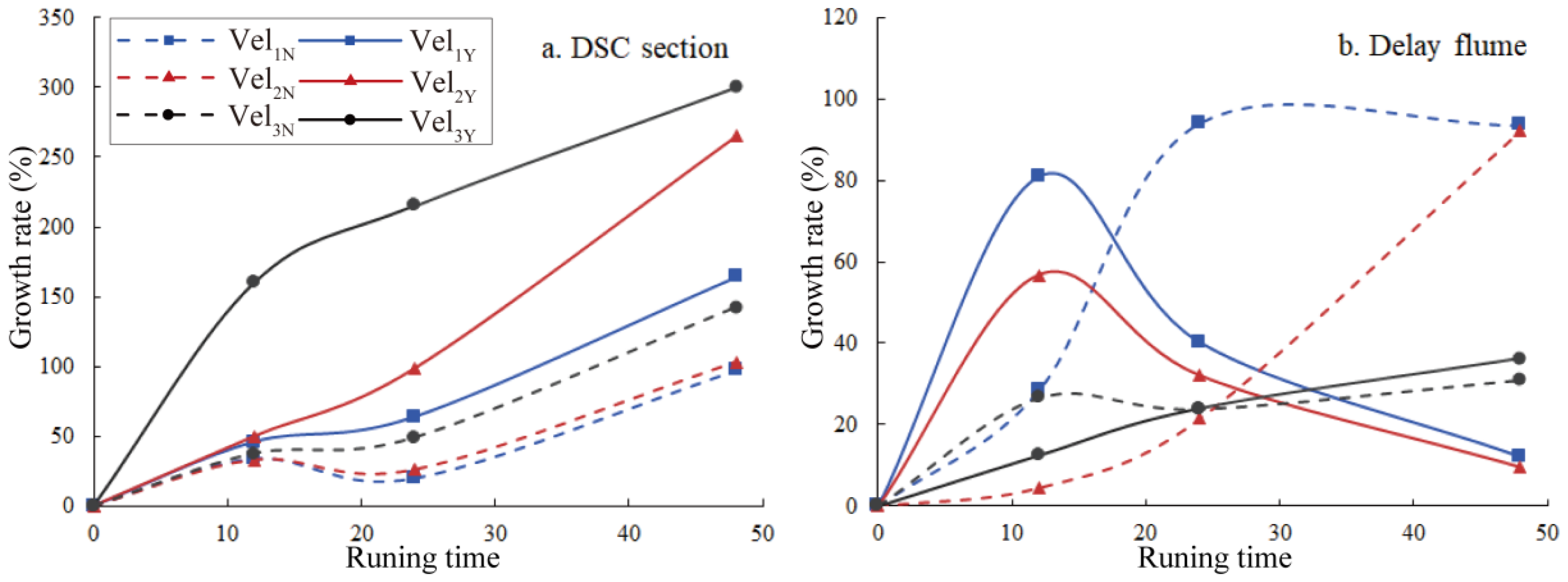

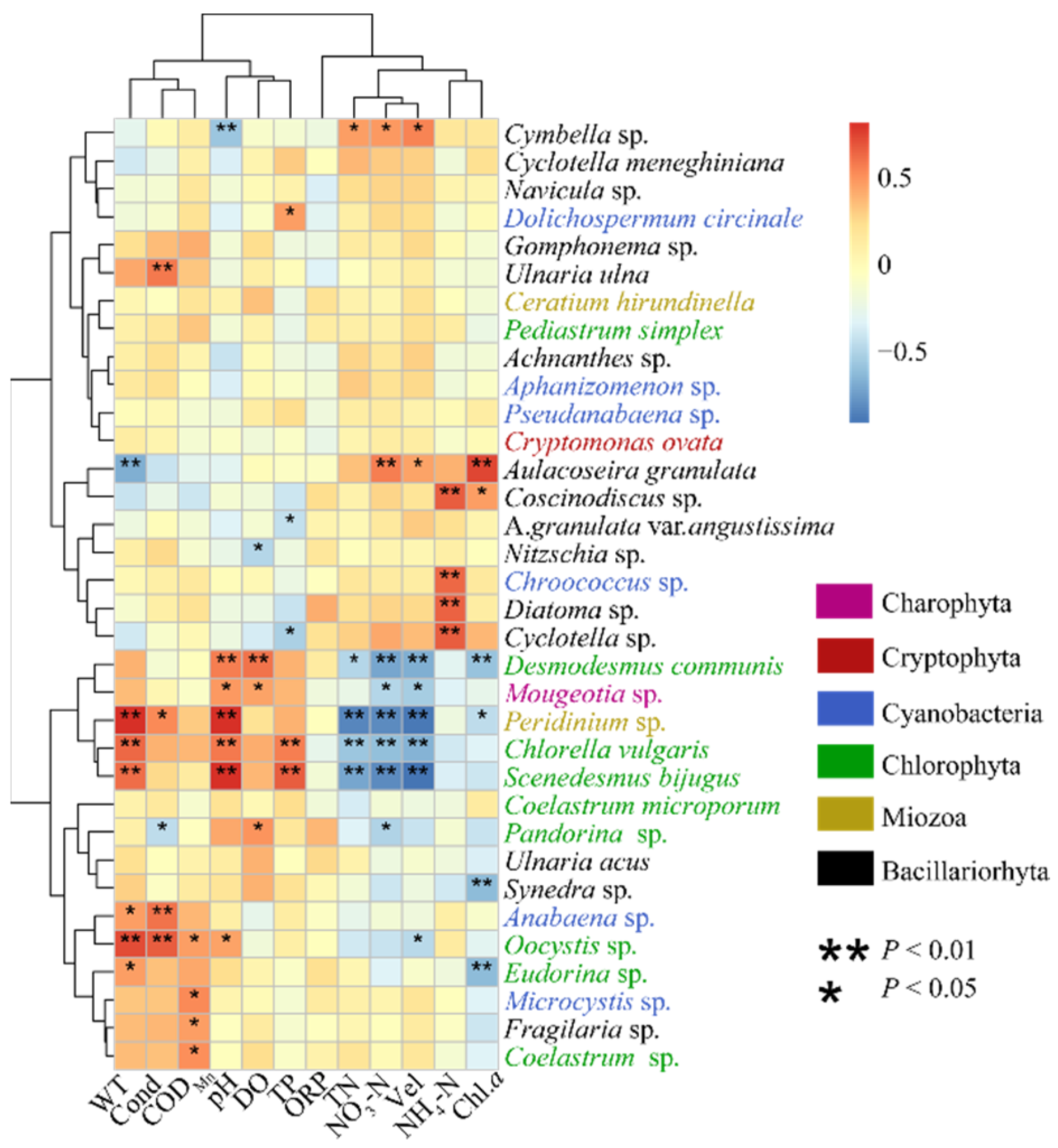
| Vel | Operational Time (h) | Detection Limit | Not Detected | |||
|---|---|---|---|---|---|---|
| 0 | 12 | 24 | 48 | |||
| N 0.025 m/s | 0.024 | 0.026 | 0.025 | 0.02 | 0.01 mg/L | “-” |
| Y 0.025 m/s | 0.02 | - | - | - | ||
| N 0.045 m/s | 0.02 | - | - | - | ||
| Y 0.045 m/s | - | - | - | - | ||
| N 0.104 m/s | - | - | - | - | ||
| Y 0.104 m/s | 0.04 | - | - | - | ||
| Vel | Operational Time (h) | Detection Limit | Not Detected | |||
|---|---|---|---|---|---|---|
| 0 | 12 | 24 | 48 | |||
| N 0.025 m/s | 0.02 | 0.015 | 0.019 | 0.015 | 0.01 mg/L | “-” |
| Y 0.025 m/s | 0.02 | - | - | - | ||
| N 0.045 m/s | - | - | - | - | ||
| Y 0.045 m/s | 0.02 | - | - | - | ||
| N 0.104 m/s | - | - | - | - | ||
| Y 0.104 m/s | - | - | - | - | ||
| Phyla | Dominant Species | Y | |
|---|---|---|---|
| Before Treatment | After Treatment | ||
| Cyanobacteria | Anabaena sp. | - | 0.022 |
| Aphanizomenon sp. | - | 0.109 | |
| Chroococcus sp. | - | 0.075 | |
| Dolichospermum circinale | - | 0.036 | |
| Microcystis sp. | 0.128 | 0.116 | |
| Pseudanabaena sp. | 0.021 | 0.026 | |
| Chlorophyta | Chlorella vulgaris | 0.05 | 0.091 |
| Coelastrum microporum | 0.022 | 0.054 | |
| Coelastrum sp. | 0.053 | 0.149 | |
| Desmodesmus communis | 0.027 | 0.031 | |
| Eudorina sp. | - | 0.035 | |
| Oocystis sp. | 0.037 | 0.093 | |
| Pandorina sp. | - | 0.055 | |
| Pediastrum simplex | 0.021 | 0.054 | |
| Scenedesmus bijugus | 0.043 | 0.076 | |
| Bacillariophyta | Achnanthes sp. | - | 0.031 |
| Aulacoseira granulata | 0.501 | 0.517 | |
| A. granulata var. angustissima | - | 0.197 | |
| Coscinodiscus sp. | 0.032 | 0.059 | |
| Cyclotella meneghiniana | 0.025 | 0.027 | |
| Cyclotella sp. | 0.451 | 0.469 | |
| Cymbella sp. | 0.548 | 0.487 | |
| Diatoma sp. | 0.02 | - | |
| Fragilaria sp. | 0.095 | 0.07 | |
| Gomphonema sp. | 0.028 | 0.034 | |
| Navicula sp. | 0.162 | 0.294 | |
| Nitzschia sp. | - | 0.026 | |
| Synedra sp. | 0.07 | 0.053 | |
| Ulnaria acus | - | 0.157 | |
| Ulnaria ulna | - | 0.057 | |
| Miozoa | Ceratium hirundinella | 0.021 | 0.063 |
| Peridinium sp. | 0.087 | 0.086 | |
| Cryptophyta | Cryptomonas ovata | - | 0.022 |
| Charophyta | Mougeotia sp. | 0.02 | 0.049 |
Publisher’s Note: MDPI stays neutral with regard to jurisdictional claims in published maps and institutional affiliations. |
© 2022 by the authors. Licensee MDPI, Basel, Switzerland. This article is an open access article distributed under the terms and conditions of the Creative Commons Attribution (CC BY) license (https://creativecommons.org/licenses/by/4.0/).
Share and Cite
Yao, Y.; He, K.; Li, Y.; Zhang, X.; Ma, Z.; Cui, Z.; Zheng, W.; Messyasz, B.; Chen, X. Research and Application of Supersaturated Dissolved Oxygen Technology Combined with Magnetization Technology in the Improvement of Water Quality: Taking the South-to-North Water Diversion Project of China as a Pilot Project. Sustainability 2022, 14, 2684. https://doi.org/10.3390/su14052684
Yao Y, He K, Li Y, Zhang X, Ma Z, Cui Z, Zheng W, Messyasz B, Chen X. Research and Application of Supersaturated Dissolved Oxygen Technology Combined with Magnetization Technology in the Improvement of Water Quality: Taking the South-to-North Water Diversion Project of China as a Pilot Project. Sustainability. 2022; 14(5):2684. https://doi.org/10.3390/su14052684
Chicago/Turabian StyleYao, Yinlei, Kang He, Yuying Li, Xia Zhang, Zhaolong Ma, Zhenzhen Cui, Wenjun Zheng, Beata Messyasz, and Xiaonuo Chen. 2022. "Research and Application of Supersaturated Dissolved Oxygen Technology Combined with Magnetization Technology in the Improvement of Water Quality: Taking the South-to-North Water Diversion Project of China as a Pilot Project" Sustainability 14, no. 5: 2684. https://doi.org/10.3390/su14052684






